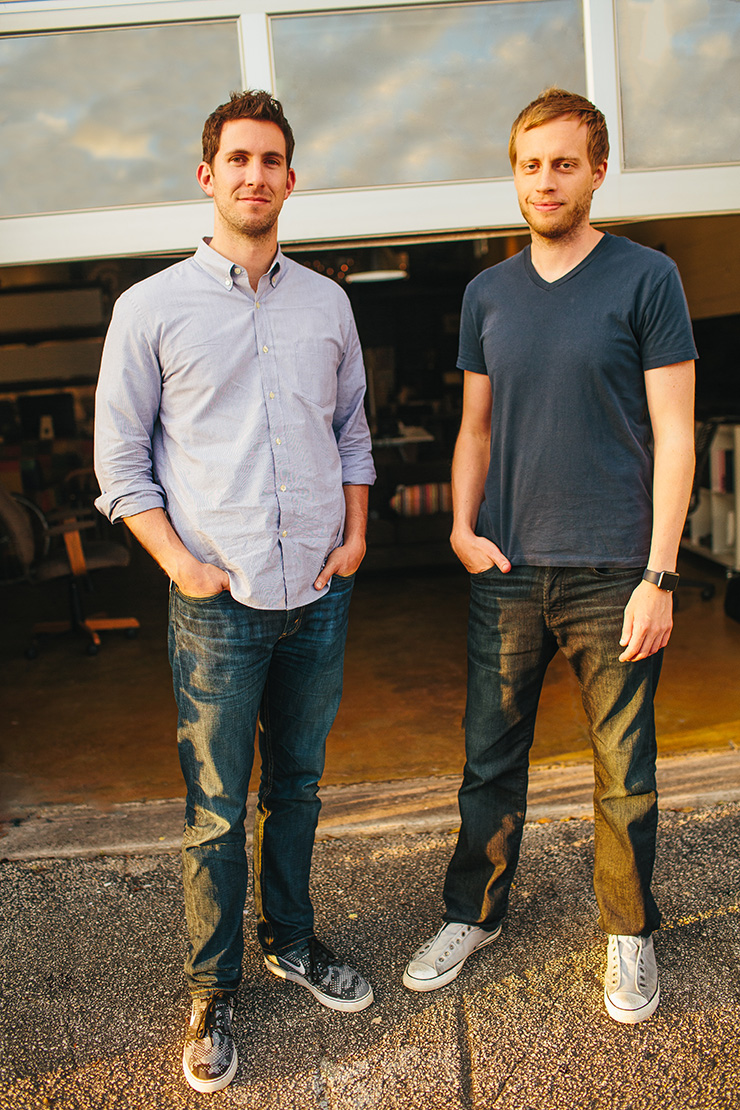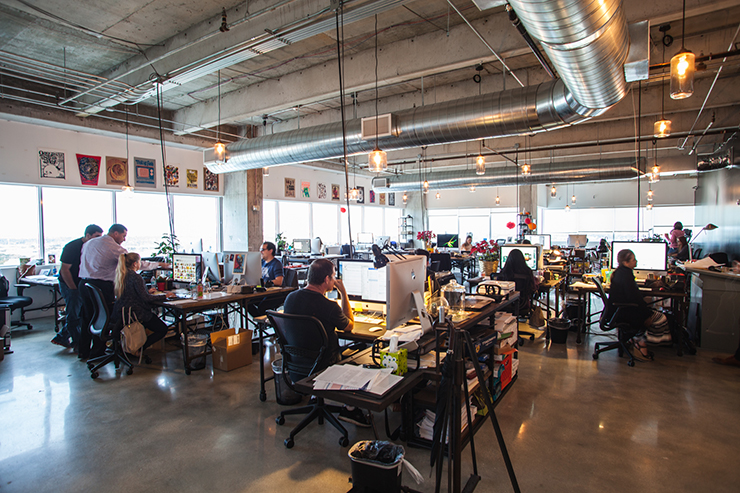By David Lyons
Glued to computer screens on an upper floor of a downtown Fort Lauderdale high-rise, more than three dozen artists and software developers toil in a vast workspace created by their employer, Mad Studios, a full-service creative ad agency. Founded in 2001, it is a business that has morphed from a print ad shop into a full-fledged developer of apps, websites, interactive videos and graphics.
Casual dress, hockey tables, dodge balls, a vaulted ceiling and worktables with hewn surfaces combine to fuel a collaborative process. The office space is cool and quirky, but effective from a business culture point of view, says founder and owner Marc Aptakin. He’s an artist-turned-entrepreneur who sees value in technologies developed in-house. “I always say I prefer to die by my own hand than somebody else’s, and that is the philosophy we’ve taken,” he says. “I know this isn’t the smartest thing to say from a business standpoint, but we don’t always look at it from a monetary view. Sometimes we look to just try to solve problems for ourselves.”
Made by their own hands or not, consumers and businesses alike are hungry for technologies to make their lives easier. So, it follows that technology developers are devising myriad ways for consumers to better identify retail products to buy, access medical records, communicate with one another, or even order coffee.
For his self-funded Mad Studios, Aptakin formed a division called Mad Dev to develop homegrown technologies. He hired Chris Stegner, a serial startup founder and former technology vice president at Weston-based Catalogs.com, to be a full partner, joining Mad Dev founding partner Olivier Beuzelin, a mobile apps and biometrics specialist.
“We’ve just always identified opportunities for growth even if they didn’t necessarily make sense [for] a creative agency,” Aptakin says. “That’s how we got into the technology side a little early.”
Mad Dev fashioned its own software developed by Beuzelin to measure ad response rates, operates its own fulfillment business for customers, and recently developed a customized, augmented reality greeting card to help the industry deflect the rise of e-cards. Early feedback on the cards has been favorable, Aptakin says, though, “It hasn’t been out long enough to say it’s a success.”
Amid the high-octane evolution of South Florida’s burgeoning technology industry, small established firms such as Mad Studios are sometimes overlooked in the media crush that focuses on young first-time entrepreneurs with big ideas, startups in need of initial funding and the emergence of a regional “ecosystem” that is drawing attention from venture capitalists, support professionals and local economic development agencies.
And now, even serial entrepreneurs who previously climbed the startup mountain see South Florida as a place where growing businesses can mature while nascent ones can be launched in bunches.
“The technology ecosystem down here is growing right now,” Stegner says. “We’ve been in the technology game for a long time. It’s nice to see it’s blossoming right this second in South Florida.”
The region can draw upon a history of more than three decades in technology development as it again seeks to be a national player in the field. Through the years, Motorola developed beepers, cellphones and two-way radios at a sprawling campus in Plantation. Founded 27 years ago, Citrix of Fort Lauderdale became a stalwart in cloud computing, virtualization and remote access for Microsoft products. And just down the road from Citrix, Bendix in the 1980s developed a traffic alert and collision avoidance system (TCAS) for the airline industry.
“South Florida has been at the forefront of innovation in tech since the development of the IBM PC in Boca Raton in the early 1980s and the first smartphone a decade later,” says David Coddington, vice president of business development and also technology lead for the Greater Fort Lauderdale Alliance, Broward County’s official public/private partnership for economic development. “No other area in the world has had a greater impact on the way humanity interacts with technology.”
Since 2011, the Miami-based John S. and James L. Knight Foundation, the philanthropic arm of the former KnightRidder media company, has sunk $20 million into programs designed to grow the startup culture in Miami-Dade County, according to Matt Haggman, Miami program director for the foundation.
Institutional venture capital groups are now visiting South Florida in search of projects thanks to the emergence of not only the startup culture, but the sustainability of companies that have leveraged initial investments into promising enterprises.
The Broward-based Magic Leap, which was founded by Rony Abovitz, a University of Miami biomedical engineering graduate, is developing projects related to augmented reality and computer vision. As a result of multiple funding rounds from Google and others companies, Magic Leap reportedly is valued at $4.5 billion.

Adam Garfield, left, and Ed Gilmore, founders of SpeedETab, look to expand their mobile app from South Florida to New York and Chicago. Photo by Nick Lyons.
“They have a potential to be transformative to South Florida,” says Bob Fitts, president of the Gold Coast Venture Capital Association. “They can start importing talent because there are cool things going on.”
Other encouraging South Florida stories include Modernizing Medicine, a Boca Raton-based company founded in 2010 that helps physicians become more efficient through an electronic medical records system that stores patient, financial and operational data. “It also gives providers much more information at their fingertips at the point of care,” says the company’s chief financial officer, Karen O’Byrne, of the system, which is 100 percent Web-based. “The medical industry was on paper for their clinical records until 2009 or 2010. They were in desperate need of an overhaul.”
According to O’Byrne, Modernizing Medicine has raised $88 million through five investment rounds, which includes support from IBM. Currently, more than 9,000 care providers in the United States and its territories use the program. Bidtellect of Delray Beach, another media company, focuses on native ads, a form of digital advertising, where paid ads are so integrated into Web page content that “the viewer simply feels that they belong.” Started by John Ferber, an AOL co-founder, Bidtellect attracted $22.35 million during its second round of funding last summer. It received $4.4 million in 2012, its initial year. Now, it has 345 million users worldwide and handles more than 560 million placement bids daily.
CEO Lon Otremba says Bidtellect’s smart technology matches advertisers with publishers who operate media platforms. Bidtellect stands at the intersection of both, collecting fees for making a match. “For the first time, advertisers can think the way publishers think,” Otremba says. “They know that if consumers are engaging with their content, they are also engaging with their brand.”
Another form of buyer-merchant matchmaking is in the food and beverage industry. Consumers fed up with long lines at restaurants can rely on SpeedETab of Fort Lauderdale to expedite service. Co-founders Ed Gilmore and Adam Garfield developed an app that allows customers to place their orders on mobile devices, and drinks and food are ready for pickup upon arrival.
“Just the experience of waiting in line and the hassle with paying for items was frustrating for me,” Garfield says. “I was just amazed that technology had not caught up in hospitality the way it had in other sectors.”
Launched last year, SpeedETab counts 75 South Florida hotels, coffee shops, quick service restaurants and food trucks as clients who pay a percentage of sales and monthly subscription fees to use customized apps. The partners say they are “well into five figures in terms of users,” with shortterm plans to expand into New York and Chicago markets. SpeedETab also provides merchants with customer data, including traffic and spending patterns.
“We’re not trying to push this change on people, but it’s there as an option,” Gilmore says. “As the macro theme develops over the next few years, we’re well-positioned to take advantage of that from the user side.” With companies such as SpeedETab and others, it looks like South Florida is becoming a hotbed for technology. Not a bad way to progress from beepers, cellphones and two-way radios.
Originally appeared in the Spring 2016 issue.




